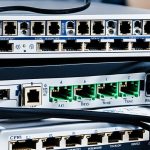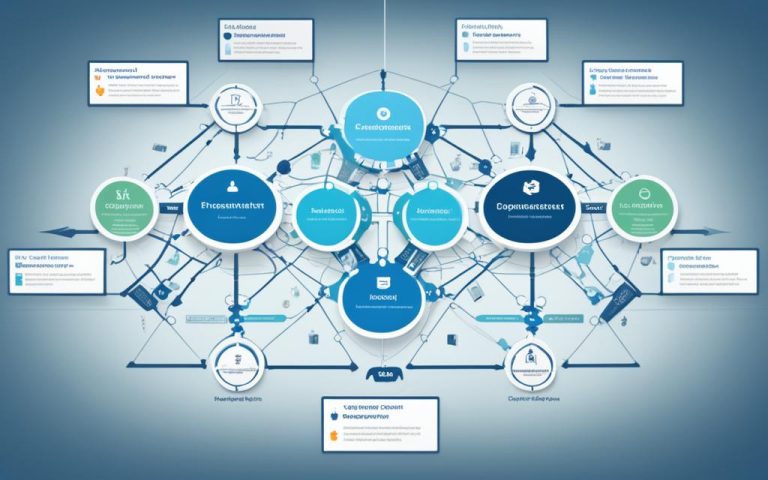Firewalls have been key to network security since the late 1980s1. They’ve grown to be a crucial barrier between private and public networks. This ensures the safety and security of digital assets. Firewalls check and filter data based on set security rules. They are vital in controlling network traffic and stopping cyber threats1.
With more internet use, firewalls are now vital for protecting data and stopping cyber attacks2. They keep sensitive data safe by checking and managing network traffic3. Firewalls have advanced features like intrusion prevention and encrypted traffic checks. This makes them more effective in today’s digital world3.
Firewalls have many features that boost network security. Next Generation Firewalls and Network Firewalls offer top-level protection. They prevent threats, control applications, support hybrid clouds, and scale well1. They do packet filtering, stateful inspection, NAT, and logging, among other things3. Firewalls are key in stopping malware and application attacks. They keep the network safe from unauthorized access and threats1.
There are different types of firewalls, like packet filtering and Next Generation Firewall (NGFW132. Stateful inspection firewalls check packets over time to see if they belong to an ongoing connection2. Application layer firewalls check packet contents to spot valid requests from possible threats3. They protect against many cyber threats, stopping attacks on various fronts2.
Firewalls also help with network address translation (NAT) and virtual private network (VPN) functions1. NAT changes internal IP addresses to external ones, and VPNs secure remote access for employees1. These features keep sensitive info safe, even when accessed from afar1.
Next Generation Firewalls are now crucial for cybersecurity. They can identify apps like Skype and enforce security rules based on the app type1. They include technologies like intrusion prevention and antivirus, offering full protection against malware and threats13. Next Generation Firewalls are essential for fighting the ever-changing cyber threats1.
Key Takeaways
- Firewalls are key in monitoring network traffic and security, stopping cyber attacks and protecting data12.
- Firewalls started in the late 1980s and have grown to meet network security needs1.
- Next Generation Firewalls offer traditional and advanced features like intrusion prevention and encrypted traffic checks3.
- Firewalls come in types like packet filtering and NGFW, each with different security levels132.
- Firewalls block malware and application attacks, and provide NAT and VPN functions1.
The History of Firewalls
Firewalls have been around since the 1980s, starting with basic packet filtering. This laid the groundwork for today’s firewalls4. Early forms of protection, like the Great Walls of China and European castles, were the first steps towards modern firewalls. They were meant to keep out threats, just like today’s firewalls do for cyber attacks.
In the late 1980s and early 1990s, firewalls started to take shape. AT&T Bell Laboratories made a big leap with the first circuit-level gateway4. This technology let firewalls filter network traffic with set rules, starting packet filtering firewalls.
The 1990s brought the first packet filtering firewalls4. These looked at each network packet and decided if it could pass or not, based on rules. Though good for basic security, they had limits, like not tracking connection states.
By the early 2000s, stateful firewalls came along4. These didn’t just look at packets; they kept track of connections too. This made them better at monitoring and securing networks by understanding the traffic context.
UTM systems also appeared, combining firewalls with antivirus, intrusion detection, and spam filtering4. This gave companies a full security package, tackling various threats at once.
In 2008, the third generation of firewalls started with Palo Alto Networks’ NGFW4. NGFWs changed the game with deeper inspection, IPS, and security policies based on apps, users, and content4. They could see all applications on the network and enforce strict security rules4. Plus, they could check encrypted traffic, tackling the rise of internet encryption4.
Firewalls are still evolving, with new technologies to fight the latest threats. Knowing their history helps us see how far network security has come. It also shows the ongoing work to protect our digital world.
Types of Firewalls
Firewalls are key to keeping networks safe. They protect sensitive data and stop unauthorized access. There are many types of firewalls, each with its own way of filtering data.
Packet filtering firewalls check a small part of data at the network level. They decide where to send it based on certain rules. This type is good for small groups needing basic security5.
Proxy service firewalls work at the application level. They filter messages by knowing the services they’re for. These firewalls add an extra security layer by watching and controlling traffic at the application level6.
Stateful inspection firewalls go further by watching active connections. They look at connection states, IP addresses, and what’s inside the data. This helps them filter traffic well and keep things secure5.
Next-generation firewalls (NGFWs) bring even more security. They use deep packet inspection and check at the application level. NGFWs can spot and stop complex cyber attacks6.
When picking a firewall, think about what your network needs and how much security it requires. Each firewall has its own strengths and weaknesses. Consider things like how well it works, how secure it is, its cost, how it affects network speed, and how hard it is to manage6.
Importance of Firewalls
Firewalls are key to keeping networks safe from threats. They protect organizations by blocking unauthorized access and preventing data breaches. As cyber threats grow, firewalls are more important than ever.
Next-Generation Firewalls (NGFWs) are advanced security tools. They can be software or hardware and stop complex attacks at different levels7. NGFWs go beyond basic firewalls by deeply inspecting traffic and knowing about applications7.
Web Application Firewalls (WAFs) protect web apps from harmful traffic7. They block attacks like cross-site forgeries and SQL injections7. WAFs keep web apps safe and protect user data.
Firewall as a Service (FWaaS) adds cloud-based security to internet traffic7. It means no need for physical firewalls and makes security scalable and cost-effective.
Firewalls have been around for over 40 years8. They’ve grown to fight more threats and protect networks well8. Firewalls check traffic and stop unauthorized access7. The future of firewalls includes more automation and better integration with other security tools7.
Firewall logs are vital for monitoring and securing networks9. They help spot and stop threats, keep data safe, and plan for network needs9. Combining firewall logs with threat intelligence helps block known bad IP addresses9.
The Role of Firewalls in Network Security
Firewalls are vital for keeping networks safe and stopping unauthorized access8. They check traffic at different levels for better security8. Next-generation firewalls offer deeper checks and better security features8.
NGFWs also improve network security across an organization8. They have centralized management for consistent security policies8.
Next-generation firewalls are fast and efficient, thanks to custom technology8. This means they keep networks fast and secure at the same time8.
In summary, firewalls are key for network security and stopping unauthorized access. With more cyber threats, it’s crucial for organizations to use strong firewalls to protect their networks and data8.
| Firewall Types | Year Introduced | Main Features |
|---|---|---|
| Network Address Translation Firewalls (NAT) | 1980s | Translation of IP addresses, port numbers, and protocols to protect internal network addresses from external exposure |
| Application Layer Firewalls | 1990s | Perform in-depth inspections of network traffic, offering more thorough protection compared to earlier versions |
| Next-Generation Firewalls (NGFWs) | Early 2000s | Deep Packet Inspection (DPI), application awareness, identity awareness, sandboxing, integration of multiple firewall functionalities |
| Web Application Firewalls (WAFs) | Mid-2000s | Protection against web application-specific threats like cross-site forgeries, cross-site scripts (XSS), file inclusions, and SQL injections |
| Firewall as a Service (FWaaS) | Present | Cloud-based internet traffic inspection delivered exclusively through the cloud |
Network Layer vs. Application Layer Inspection
Network layer inspection checks packets at a basic level of the TCP/IP stack. It looks at IP addresses and ports to decide which packets to let through. On the other hand, application layer inspection works at a higher level, giving more detailed control over traffic.
Packet filtering firewalls are often used for network layer inspection. They check packets based on IP addresses, port numbers, and protocols. This method is fast because it looks at packet headers quickly, letting packets pass through swiftly.
Application layer inspection, as its name suggests, looks at traffic at the application layer of the TCP/IP stack. This layer gives a detailed view of the data being sent. It can identify specific applications, protocols, or services by analyzing packet contents. This lets for better control over traffic, helping to block unwanted applications.
Network layer inspection is fast but might let in unwanted apps or malware through allowed ports. Application layer inspection can catch and block these unwanted apps or malicious activity by looking at packet contents. But, this method can be slower and use more resources, affecting network speed.
Using both network and application layer inspection together gives a strong firewall protection. This mix filters traffic at both basic and detailed levels. It helps keep out unauthorized access and guards against different cyber threats.
Advantages of Network Layer Inspection:
- Efficient performance with quick packet analysis and processing
- Ability to block traffic from known malware and phishing sites
- Prevention of IP spoofing, brute-force attacks, and traffic with malformed packet headers
Advantages of Application Layer Inspection:
- Granular control over traffic, allowing for detection and blocking of unwanted applications
- Protection against SQL injection attacks, deserialization attacks, Layer-7 DDoS attacks, and cross-site scripting attacks
By using both network and application layer inspection, organizations can create strong firewall solutions. These solutions protect against many cyber threats.
The Importance of NAT and VPN
Firewalls are key to keeping networks safe. They block unauthorized access and protect against threats. NAT and VPN are two important parts of firewall security.
NAT lets many devices use one public IP address when they go online. This saves IP addresses, which are running out fast12. It gives each device a private IP address but uses the same public one for the internet. This keeps the network safe from outside threats13. NAT also stops unwanted traffic from getting in, lowering the risk of attacks12.
VPN makes online communication safe and private by encrypting data. It sends data through servers to keep it safe from others. NAT can make it hard to tell wanted from unwanted VPN traffic because of the encryption13. Some VPNs use NAT for extra security, giving users their own IP addresses for more privacy13. Others use port translation to keep users anonymous and manage traffic better13. NAT can slow down torrenting, but it doesn’t usually affect speed much13.
Choosing a VPN means looking at its security features. Some, like IPVanish and VyprVPN, use NAT for safe connections and let users share IP addresses13. ExpressVPN focuses on security with strong encryption and port blocking to protect users13. VPNs differ in how many devices they support. IPVanish lets up to 10 devices connect, while VyprVPN allows five. ExpressVPN supports up to three13. Some VPNs let you forward ports for torrenting, but this might risk security13.
VPN apps work on many devices, like PCs, Macs, and mobiles. They let users surf the web safely, no matter the device13.
In short, NAT and VPN are key parts of firewall security. NAT saves IP addresses and blocks unwanted traffic12. VPNs encrypt data for privacy and security. Together, they make the internet safer for everyone.
Next Generation Firewalls and Beyond
Next-generation firewalls (NGFW) have changed how we protect networks. They go beyond old firewalls by fighting new cyber threats with advanced tools. These firewalls are key to keeping networks safe today.
NGFWs give better control over what goes through the network than old firewalls14. They check deep into network traffic, know about different applications, and spot threats14. This means they can block harmful traffic and keep networks safe14.
NGFWs can stop threats before they start with Intrusion Prevention System (IPS) features14. They use smart threat intelligence and learning to fight off complex threats quickly14.
NGFWs are made to tackle today’s security challenges. They protect against advanced threats and stop malware15. They also help move towards better security centers, making it easier to handle security issues15.
But, NGFWs have limits in today’s fast-changing world15. With more people working remotely and using the cloud, NGFWs in one place can slow things down15. This means more security tools are needed, making things more complex and expensive15.
NGFWs use software to check SSL traffic for security, which can slow things down15. There are three main types of NGFWs: hardware, virtual, and cloud-based, each with its own strengths and weaknesses15.
Benefits of Next-generation Firewalls:
NGFWs bring many advantages:
- Advanced threat prevention and detection14
- Better control over network traffic14
- Specific rules for application behavior14
- Working with Intrusion Prevention Systems (IPS)14
- Using smart threat intelligence and learning14
- Full protection with antivirus, web filters, and sandboxing14
- Easy security management with central consoles14
As cyber threats get more complex, it’s crucial for companies to use NGFWs to protect against data breaches and network attacks. NGFWs offer strong defense with their advanced features against many cyber threats today.
Firewall Features
Firewalls are key in protecting networks from unauthorized access and cyber threats. They have many features that help keep networks safe.
Packet filtering is a basic feature of firewalls. It checks network packets and decides if they can enter the network. This stops bad traffic from getting in16.
Stateful inspection is another important feature. It keeps track of past packet information to check and stop threats16.
Firewalls also have network address translation (NAT). This hides IP addresses when accessing the internet, making the network safer and more private16.
Logging and monitoring are vital for tracking network activity and spotting security issues. Firewalls log events and create reports to help network admins17.
Access control lets admins set who can use the network and access certain information. This keeps sensitive info safe17.
As cyber threats grow, advanced threat prevention is key. Firewalls with this feature use deep packet inspection and IDS/IPS to catch and stop complex threats1718.
Next-generation firewalls (NGFWs) offer many advanced features. They combine traditional firewall functions with extra security steps. NGFWs are very popular today because they filter applications, use IDS/IPS, and block content18.
Firewalls also have features like URL filtering, DNS security, IoT security, and CASBs. These enhance protection against different threats17.
In summary, firewalls have many features that control network traffic and ensure strong security. From basic filtering to advanced threat prevention, firewalls are vital for protecting networks and data171816,,).
Benefits of Firewalls
Firewalls are key for keeping computers safe from the Internet. They act as a shield, watching all data coming in and going out19. They can block certain types of traffic by checking domain names or network types, giving users control over what gets through19. Firewalls come in both software and hardware forms, fitting different needs like small offices or homes19.
Firewalls stop unauthorized access and keep viruses out19. Without one, computers are easy targets because they’re open to the world19. People without firewalls must manually close ports and turn off file sharing to stay safe19. With a firewall, both groups and individuals can keep their networks and data safe.
Firewalls also control who can get into a network, making it more secure19. This is crucial for companies, where they can watch and block unwanted traffic20.
They make remote work safer by creating a secure link to the office21. Using VPNs with firewalls keeps data safe and private21. This is great for companies with remote workers or those needing access from outside the office.
Firewalls help meet legal standards too. They make sure data is safe and follow the law21. They also keep data private and stop unauthorized access21.
New firewalls offer even more benefits. They can spot threats better, know who’s on the network, and manage apps21. Some firewalls share threat info automatically, helping companies stay ahead of security issues21.
In summary, firewalls are vital for watching traffic, stopping viruses, controlling access, and boosting security. They help protect networks, data, and resources from threats.
Conclusion
Firewalls are key to keeping networks safe by watching and controlling traffic. They make sure digital assets are secure. With new cyber threats always coming up, it’s vital to use firewalls that work at different levels to protect fully22.
Firewall monitors are vital for better network security. They watch traffic in real-time, spot unusual patterns, and respond quickly to threats. This helps organizations understand their network better and meet security standards22.
There are different types of firewalls, like hardware and Next Generation Firewalls (NGFW). Hardware firewalls act as a strong barrier against cyber threats. NGFWs add more security with features like stopping intrusions and checking encrypted traffic. Packet filtering, stateful inspection, and web application firewalls also play a big role in keeping data safe23.
Firewalls are very important today for keeping networks safe. They stop unauthorized access and protect against data breaches. Businesses need to know how crucial firewalls are and choose the right ones for their needs2324.
In short, firewalls are essential for network security. They keep getting better to fight new cyber threats, offering many layers of protection. By using strong firewalls, companies can lower the risk of cyber attacks and keep their digital assets safe. In our connected world, firewalls are key to a strong security plan222324.
FAQ
What is the function of a firewall in network traffic monitoring?
A firewall acts as a shield between your network and the outside world. It checks data against security rules to keep your network safe. This stops unauthorized access and protects your network.
How has the concept of firewalls evolved over time?
Firewalls have changed a lot over the years. They started fighting viruses on single PCs in the late 1980s. Now, they tackle big, complex attacks with advanced tools.
What are the different types of firewalls?
There are many types of firewalls. You can find packet filtering, proxy service, stateful inspection, and next-generation firewalls. Each type filters data in its own way.
Why are firewalls important for network security?
Firewalls are key for keeping your network safe. Next-generation firewalls block malware and fast attacks. They help protect your digital stuff from threats.
What is the difference between network layer inspection and application layer inspection?
Network layer inspection looks at packets at a basic level, focusing on IP addresses and ports. Application layer inspection checks at a higher level, giving detailed control over traffic.
What are the functions of NAT and VPN in relation to firewalls?
NAT hides or changes internal IP addresses to save IPv4 addresses and hide your network. VPN creates a secure tunnel for data to move over the Internet, keeping it private and safe.
What are next-generation firewalls and their advanced features?
Next-generation firewalls (NGFW) are more than traditional firewalls. They have features like intrusion prevention systems (IPS), advanced threat prevention, and sandboxing. These help catch and stop malware and complex threats targeting apps.
What are some of the features offered by firewalls?
Firewalls have many features. They do packet filtering, stateful inspection, and advanced threat prevention. They also filter URLs, secure DNS, and use cloud access security brokers (CASBs) to fight cyber threats and boost security.
What are the benefits of using firewalls?
Firewalls watch and control network traffic. They stop unauthorized access and guard against viruses and malware. They also manage access, secure remote work, and help with security by logging and monitoring.
How important are firewalls for network security?
Firewalls are vital for keeping your network safe. They watch and manage network traffic, stopping unauthorized access and cyber threats. As cyber threats grow, firewalls will keep being a key part of security plans.
Source Links
- https://www.checkpoint.com/cyber-hub/network-security/what-is-firewall/ – What is a Firewall? The Different Types of Firewalls – Check Point Software
- https://www.techtarget.com/searchsecurity/definition/firewall – What is a Firewall and Why Do I Need One? | Definition from TechTarget
- https://www.paloaltonetworks.com/cyberpedia/what-is-a-firewall – What is a Firewall? | Firewall Definition
- https://www.paloaltonetworks.co.uk/cyberpedia/history-of-firewalls – The History of Firewalls | Who Invented the Firewall?
- https://www.paloaltonetworks.com/cyberpedia/types-of-firewalls – Types of Firewalls Defined and Explained
- https://www.techtarget.com/searchsecurity/feature/The-five-different-types-of-firewalls – The 5 Different Types of Firewalls Explained
- https://nordlayer.com/learn/firewall/what-is-firewall/ – What is a Firewall? Types, history, methods & importance
- https://www.fortinet.com/resources/cyberglossary/benefits-of-firewall – What are the Benefits of a Firewall? | Fortinet
- https://www.manageengine.com/products/eventlog/logging-guide/firewall/importance-of-firewall-logging-and-monitoring-in-network-security.html – Importance of firewall logging and monitoring in network security
- https://www.linode.com/docs/guides/network-firewalls-vs-application-firewalls/ – Network Firewalls vs. Application Firewalls
- https://www.geeksforgeeks.org/types-of-network-firewall/ – Types of Network Firewall – GeeksforGeeks
- https://surfshark.com/blog/nat-firewall – NAT firewall: what is it, and do you need one in 2024?
- https://www.comparitech.com/blog/vpn-privacy/nat-firewall/ – What is a NAT firewall, How Does it Work and When Do You Need One?
- https://safari-solutions.com/how-next-generation-firewalls-strengthen-cyber-security/ – How Next-Generation Firewalls Strengthen Cyber Security | Safari Solutions
- https://www.zscaler.com/resources/security-terms-glossary/what-is-next-generation-firewall – What Is a Next-Generation Firewall?
- https://www.forcepoint.com/cyber-edu/firewall – What is a Firewall?
- https://www.checkpoint.com/cyber-hub/network-security/what-is-firewall/what-is-firewall-software/ – What is Firewall Software? – Check Point Software
- https://builtin.com/articles/firewall – What Is a Firewall? (Definition, Types, Examples) | Built In
- https://iet.ucdavis.edu/content/computer-security-tip-firewalls – Computer Security Tip: Firewalls
- https://www.simplilearn.com/tutorials/cyber-security-tutorial/what-is-firewall – What Is Firewall: Types, How Does It Work & Advantages | Simplilearn
- https://www.paloaltonetworks.co.uk/cyberpedia/what-are-the-benefits-of-a-firewall – What Are the Benefits of a Firewall?
- https://www.cloudns.net/blog/firewall-monitor-explained-enhancing-network-protection/ – Firewall Monitor Explained: Enhancing Network Protection – ClouDNS Blog
- https://www.paloaltonetworks.com.au/cyberpedia/what-is-a-firewall – What is a Firewall? | Firewall Definition
- https://www.spiceworks.com/it-security/network-security/articles/what-is-firewall-definition-key-components-best-practices/ – What Is a Firewall? Definition, Key Components, and Best Practices – Spiceworks



















